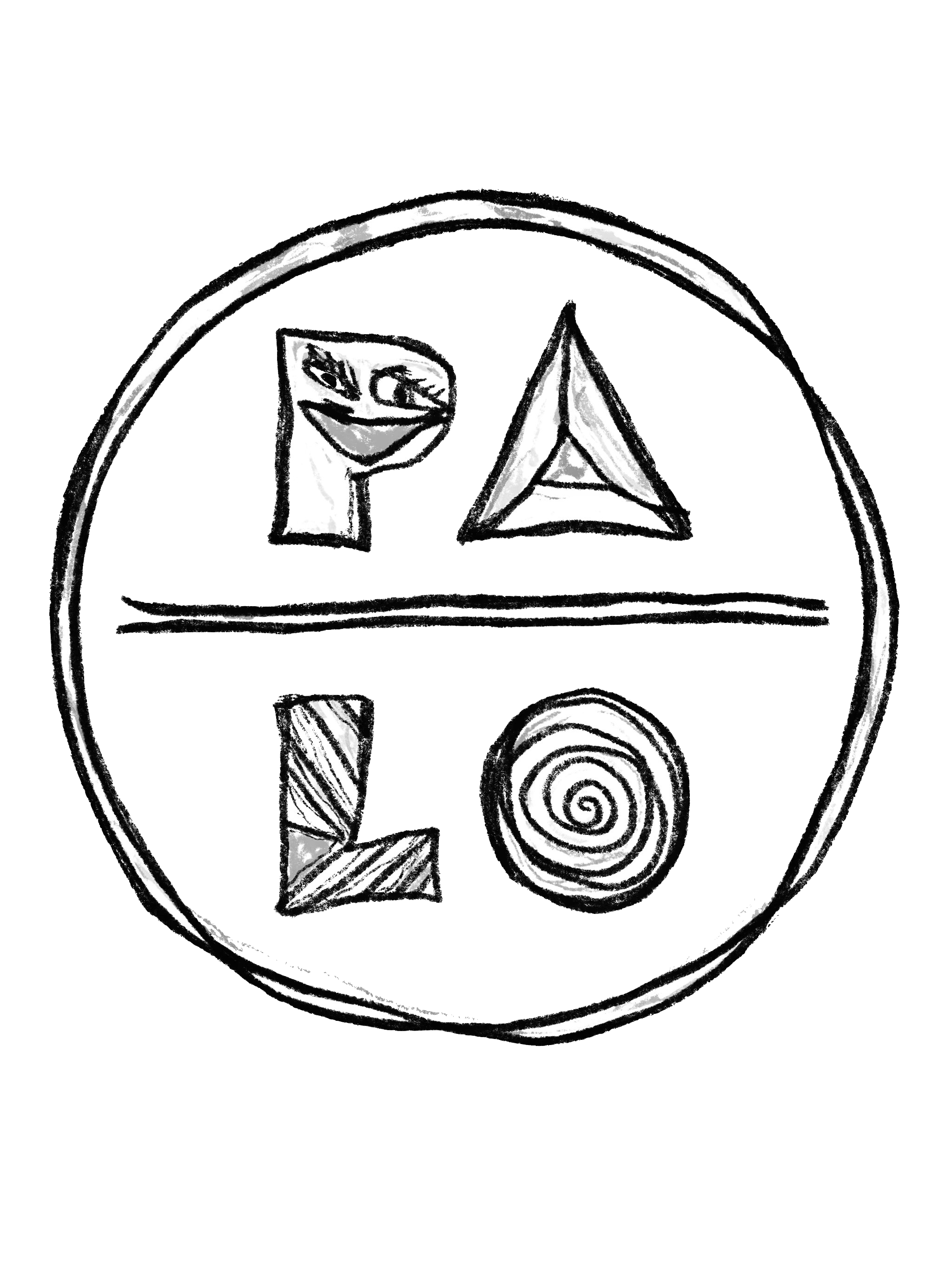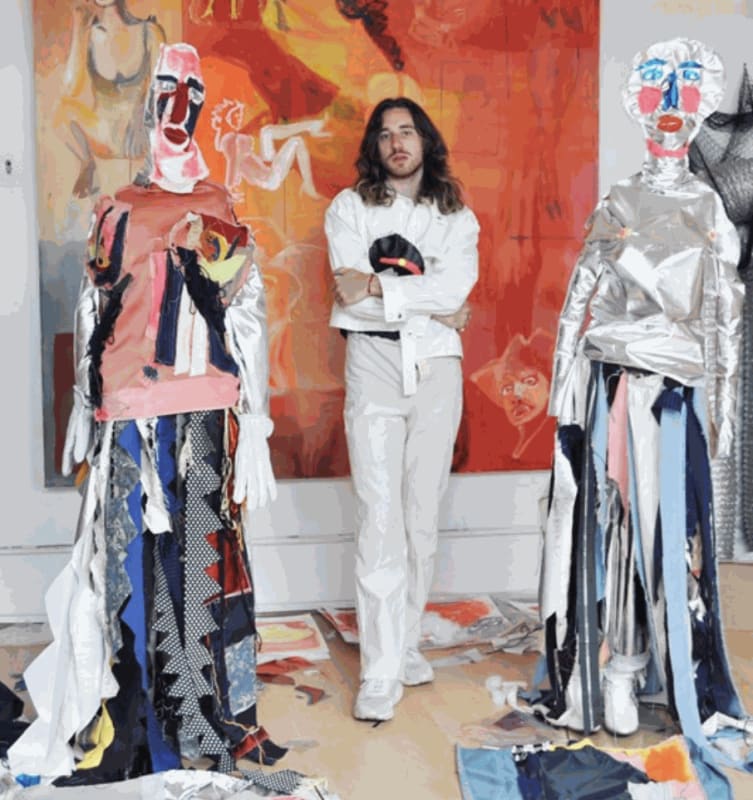Sharper Than Razor Blades mines the artist’s autobiography to explore how identity is built
While most people would prefer to leave their teenage hairstyles in their adolescence, British artist Alexander James has brought his front and centre for his latest exhibition, Sharper Than Razor Blades. “I went through several styles and phases during this period”, explains James when speaking about highschool, “and this exhibition was mainly sparked by a memory of the punk hairstyle which I had when I was younger. My hair was so spiky that it nearly hit the doorframes of the classrooms.”
Previously on show at London’s Working Projects in Westbourne Grove, the coiffure is just one of the memories that James expands on in the exhibition which probes identity, digitalisation, and materiality in today’s world. Using mixed media sculpture, digital collage, and painting, James explores how identity can be moulded through clothing and uniforms while nodding to subcultures and social groups. Below, we speak to the artist to find out more.
Your childhood influenced this exhibition, can you expand on that?
Alexander James: I found my childhood and growing up a curious process of its own. Therefore, when I create works it usually reflects on references from different instances from my earlier years. I moved across several schools in my youth. The school that I finally ended up at was quite unconventional in terms of its own uniform, which gave every student the ability to discover their own uniform. In terms of my personal development, a lot of expression came from this, and I went through several styles and phases during this period, which is heavily explored in the Sharper Than Razor Blades exhibition. I always reveal in my artworks an element of my past life into the characters; I guess it’s a self-reflection to what’s led me to this point of my life.
My grandfather was also someone that I looked up to heavily when he was around. I spent a lot of time at his house when I was growing up. Cartoons weren’t an option at his place, and we instead watched black and white western films together, which is a time that I cherish heavily. One of his favourite westerns were High Moon by Fred Zimmerman, which was based in New Mexico.
Can you tell us more about the symbols and the characters you tend to paint?
Alexander James: The characters in my artworks are all triggered by a number of my childhood memories. In my artworks, I create the characters from either an obvious or subtle childhood references. As I previously mentioned, I explored several trends and phases, and this exhibition was mainly sparked by a memory of the punk hairstyle which I had when I was younger. My hair was so spiky that it nearly hit the doorframes of the classrooms. This image is intertwined with the composition and engaging the gaze of the strong female characters in my work. These two themes combined created the title Sharper Than Razor Blades. This was definitely my most responsive phase at school and caused the most attention, both good and bad, so it’s something that definitely stuck with me the hardest.
Are there links between your sculptures and your paintings, or do you utilise these mediums separately?
Alexander James: There are some obvious and more subtle connections to the paintings and sculptural works, especially in the portraits of my characters. The original sketches and paintings I created nearly two years ago in New Mexico and Arizona are what triggered the sculptural works in this exhibition, so there is a strong link between the two avenues. Taking the portraits from my characters out of the paintings and applying a new 3D form was the first tie. The portrait of ‘Zeus’ was taken from a character in the painting ‘Find Me First – 10 am’. Matilda was created from a line drawing, to begin with, which later led me to create a smaller portrait shown on the fabric work ‘Satellite Dish’. Shortly after creating the portrait, I knew that I wanted to create a life-size standing 6ft sculpture that will stand next to Zeus.
I applied the same mental process as I do for the paintings as for my sculptural works. There were definitely times that a whole new process got developed into the works, which I enjoyed but I also found challenging. There was a lot of trial and error, as well as going backwards and forth. It challenged me to be sharp with decision-making and to be able to recognise what the strengths which were to push forward. Afterwards, I continued to rebuild the other elements until I found a happy medium. The process for both mediums started with a lot of collage, whether it was collaging fabrics together on top of each other or exploring a colour palette and layering the diverse characters.
What role do the fabrics and materials you choose to use play in informing the works themselves?
Alexander James: I took a lot of consideration into the materials I used and was very selective when deciding which to utilise. I wanted to show the viewer a selection of fabrics which I have previously worn and always enjoyed such as denims, suedes, pinstripes and cottons. It was a good opportunity for me to re-use and recycle fabrics that have been lying around in my wardrobe from different unforgettable times in my life. If I were still looking for more fabrics to include in my works I would shuffle through the offcuts in fabric stores and ask friends who are working within the fashion industry to pass onto me the fabric from previous fashion seasons. So the role of the fabrics in my artworks is hugely important and personal to me.
Where do you take your influences from?
Alexander James: If I am not taking influence by tapping into older memories, I will be taking influence from scenic environments and settings. I found this especially poignant New Mexico and Arizona when I was travelling, a place where I felt that time has no urgency and space was so widely accessible. I had a structured process of immediately sketching the minute I woke up from the insane dreams that I had. It was a very isolated place and definitely allowed the mind to wander in mysterious ways. I created certain characters whilst I was there, that I would have preferably loved to see in the environment that I was staying in. I wanted to bring them to life at the time by creating three-dimensional sculptures but I didn’t have the resources to do so until I got back to London. I continued to build video content that I later experiment with; which sparked a lot of my thought process. It allowed me to look at my surroundings on a wider scale. Video is where I find the roots to most of my ideas; I’m obsessed with collaging, pausing clips, finding stills from different scenes and replaying sections that I can make artwork from. Even before the times that I knew how to edit videos, I was always drawing ideas from films, trying to catch some form of distortion by pausing it at a random time and then sketching the film character’s faces turning them into something that is unrecognisable.
I also continuously reminisced my earlier years, particularly that period which I was at finishing school, which stemmed my interest in looking at different subcultures and movements. Seeing where society is currently at and the way that it will change with this ever-evolving digital world has influenced my recent works. With constant progress in technology and digitalisation across several spheres, I believe that there will also be new movements and subcultures made from this.
You’ve got a strong following of 32,000 followers on Instagram. How do you think Instagram has changed how people create and consume art?
Alexander James: It has definitely added to the way viewers consume art because there’s a lot more availability of content for their gratification. Now, anybody can access an artist’s work halfway across the world in a matter of seconds, which is unfounded. Saying that, I don’t think viewing artwork via social media platforms such as Instagram is anywhere near as exciting as seeing the works in person. I think it has helped people find more opportunities as well, which is a positive step. It has so many pros and cons.
Can you tell us about your upcoming shows and what we can expect in terms of work and themes etc?
Alexander James: I’m planning some exciting projects, which are being finalised in New York and Paris towards the end of 2019.

